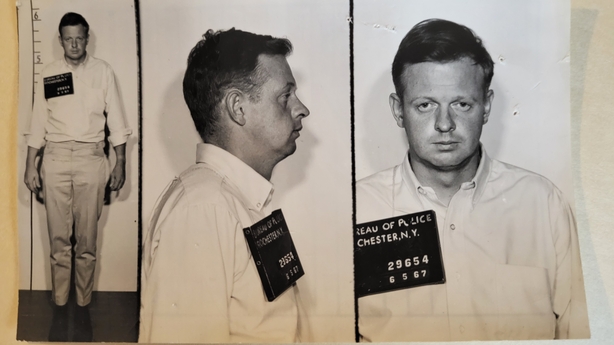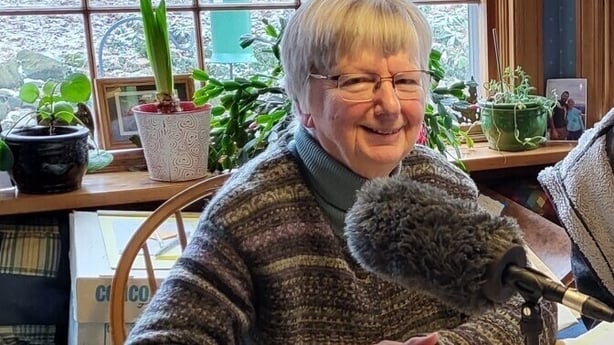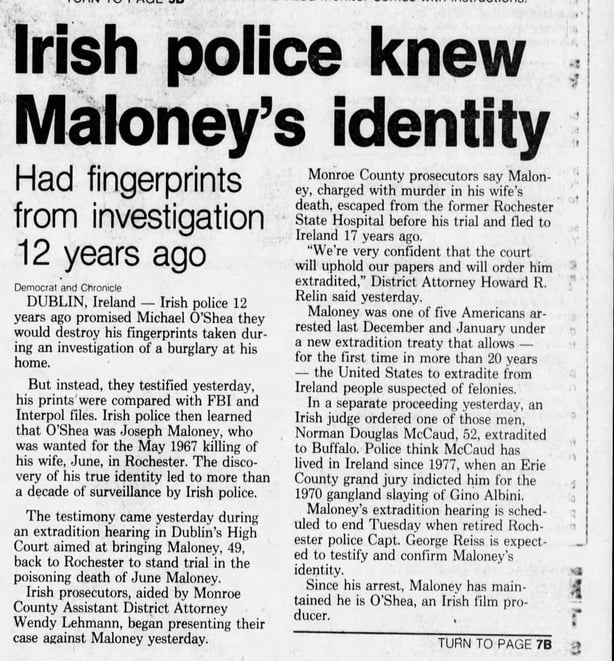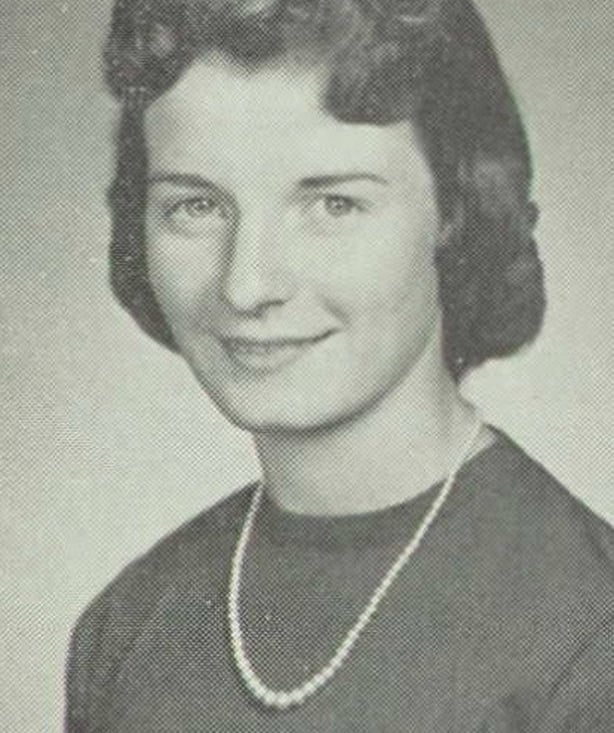The month of January is in full swing, and most of us have hopefully given up on the delusion of using that gym membership or investing in cryptocurrency (shudders). Instead, let us focus on honing more important life skills - like catching an alleged murderer who has been on the run for nearly 60 years.
From the multi-award-winning team behind podcasts like The Nobody Zone and Finding Samantha comes Runaway Joe, the story of a US fugitive who took refuge in a sleepy Irish coastal town. That was until two investigators from opposite sides of the Atlantic decided to join forces in search of justice.
Let's rewind: In 1967, Joseph Maloney was accused of poisoning his wife, June, at their son's fifth birthday party. She was 26. He managed to evade the US authorities (including the FBI) and fled to Ireland for a few decades before hoodwinking the authorities once more in the late 1980s.
He has been on the run ever since.
In the proceeding years, news of Joseph Maloney completely dried up. That is until the Doc On One team got involved. Journalist Pavel Barter, producer Tim Desmond, and researcher Nicoline Greer have been searching for this wanted man for close to two years.
I could tell you what they found, but this is a live investigation unravelling at warp speed. Also, I would lose my job, which would not be ideal…
Instead, tune in every Friday for new episodes.
Special guests include An Garda Síochána, the FBI and the Rochester New York District Attorney’s office.
If you still don't trust my advice (rude) keep reading for a full breakdown of episode one of Runaway Joe.
Who Is Michael O’Shea?
Truthfully, I’m not qualified to answer that question, both my law degree and doctorate in psychology are still pending, but I can tell you what I know.
In 1985, a well-dressed middle-aged man with greying red hair came before a district court judge in Dún Laoghaire. He was pleasant, tall and had "penetrating eyes".
His name was entered into the court records as Michael O’Shea. He owned property in South Dublin and a large estate in the midlands. He had lived in Ireland for around 17 years, worked in the film industry and married a Dublin woman Sheila Chandler.
The judge presiding over the case, Gillian Hussey, takes the listener back in time to that fateful day. She was perplexed by the strange array of people that filled her courtroom; a mix of affluent South Dubliners and mysterious guests from across the Atlantic.
But, why was this upstanding citizen in Judge Hussey’s courtroom? Because according to the Gardaí, INTERPOL and the FBI his identity was fake, not only that he was a wanted man.
His real name was Joseph Maloney.

You wouldn't call him handsome, but he was very striking and he had a fantastic presence about him. He had very deep penetrating eyes - Filmmaker and novelist Maurice O’Callaghan
The Investigators
The podcast features lengthy interviews with Former Prosecutor Wendy Lehmann and Garda Superintendent John Mulderrig. The pair teamed up 40 years ago to corner Maloney after he escaped to Ireland.
Barter opens the episode meeting Lehmann in her kitchen in upstate New York. She has given the podcast access to some of the original case files.
We then hop 3000 miles across the Atlantic to get the inside scoop from Superintendent Mulderrig. A man who brings new meaning to the phrase always trust your gut. In 1969, he became suspicious of a mysterious newcomer working on fishing trawlers in Dún Laoghaire, South County Dublin.
There was something about this individual, Michael O’Shea (Maloney) that just did not add up.
According to the Superintendent, Maloney told locals that he was an expert in explosives, in the car business and also a farmer.
"Anyone that spoke with him got a different story from him. And I often wondered, which was the true story." The Superintendent knew he needed to establish his true identity, but how?
Thankfully, Maloney’s lack of conflict resolution skills was his downfall and the Gardaí were called after he was involved in an incident.
During a technical examination, the authorities fingerprinted the occupants of the home, and that included Maloney. The only difference was his prints were sent to INTERPOL.
The Gardaí got a hit, and the chase was on.
Ireland knew him as Michael O’Shea. His real name was Joseph Michael Maloney - Former DA Wendy Lehmann
Red Tape
At this point, you’re likely wondering, why am I still reading this delightful article? The two nice investigators have got this covered, well yes, but not exactly.
Extraditing a wanted felon is not as easy as it sounds. In the words of my father: "bureaucracy ruins everything," in this case, it kind of did.
So, in 1973, there was no extradition treaty between Ireland and the US, which meant the Gardaí had no legal route to send Maloney back to face trial. They did not want to tip their target off, so they had to keep his true identity a secret until a treaty was signed/ratified.
They kept their lips sealed for over ten years. My secret-keeping record is six hours, how about you? And remember Dún Laoghaire is not that big a place: "I never spoke with him over their years, never spoke with him. I met him on many occasions. He would always salute you, and give you the impression I know who you are. I was aware of his existence the whole time and where he lived, but other than that, there was nothing we could do."
But the work never stopped; the Superintendent kept close tabs on Maloney and gathered intel from people who knew him.
Across the water, Lehmann and the DA's office in Rochester, New York waited for the call to say the extradition treaty had been signed. The murder Maloney was accused of had taken place in their jurisdiction.
In December 1984 the US Justice Department sent word that the first bilateral extradition treaty between the Republic of Ireland and the US had been signed.
To get the deal over the line, the US had to promise the death penalty was off the table for Maloney.
Garda headquarters gave the Superintendent the green light to make his arrest (finally).
The game was back on.

I did speak with a few people that knew him, and they would say you can't believe anything he says. - Superintendent John Mulderrig
The Arrest (take two)
Finally, on 7th January 1985, Superintendent Mulderrig moved in on Maloney. He waited outside his upmarket home in south county Dublin until he returned with his wife.
He had rehearsed this moment for years, so the second Maloney arrived home he pounced. "I asked him for his name, and of course, he gave it as Michael O’Shea. But I told him that I was satisfied that his true identity was Joseph Maloney."
He arrested him on a provisional warrant at the request of the Embassy of the United States of America.
The accused told him he had got the wrong man. His wife, according to the Superintendent, did not comment.
After a quick pitstop in a jail cell at Dún Laoghaire garda station, Maloney was brought before Judge Hussey. It was a case like no other ever brought before Dún Laoghaire district court.
The terrifying thing about Joseph Maloney is he seemed completely normal even to Judge Hussey: "He wasn't a man that you really feel you have to be well enough away from whereas there were other much, much lesser criminals, that you would have been terrified to be beside."
She remanded him in custody to be taken to Mountjoy Prison.
But before he could be swept off stateside, there was an extradition hearing, and before that, there was a bail request, which meant the high court. See, isn’t bureaucracy exhausting?
So, where does that leave our favourite investigators? Well, before Lehmann could finally have her day in court she had to ensure Maloney’s bail request was rejected. That meant finding a way to prove Michael O'Shea was Joseph Maloney.
He said look, there's going to be a strange case in the afternoon and the court will be full of people that you wouldn't expect to see in the court - Retired district court Judge Gillian Hussey

Courtroom Surprises
At this point in our tale, Prosecutor Wendy Lehmann needed to prove the identity of our suspect. If she failed, he got to walk free.
But she had a plan, a surprise guest was going to attend the bail hearing in Ireland.
Someone from our fugitive's past who could identify him with certainty. I could reveal who the prosecutor's secret weapon was, or you could also just start streaming.
If your brain works anything like mine (sincerest apologies) you are likely wondering how Maloney’s second wife Sheila Chandler was coping. She stood firmly behind her husband, whoever he was.
Before the champagne could be broken out, the DA’s office had to get Maloney back on US soil and off the FBI’s most wanted list.
So, in March 1985, Wendy Lehmann and her husband Gary headed for the Emerald Isle.
I can't say the exact words but she said more or less; I don't care how many he's killed. I still love him - Pat Fitzsimons
The Devil Is In The Details
The extradition hearing (finally) took place in Dún Laoghaire on the 27th of March, 1985. Though she had seen his mugshot over the years, this was Lehmann’s first face-to-face encounter with Maloney. "I remember thinking you looked like Father Time. He had a long, scraggly beard, as I recall it and looked kind of diminished."
While the evidence was stacked against the namesake of this podcast, his lawyers did have one key point. His fingerprints were taken 12 years previously, in 1973, and should have been destroyed, once he was eliminated from that case.
To keep the fingerprints, they claimed, was a violation of his rights. The question is, did this theory sway Judge Hussey?
While DA Lehmann was trying to dismantle this idea, her husband Gary noticed something… unusual going on between Maloney and his wife Sheila in the courtroom.
Sheila kept a large purse between herself and her husband at all times, strange for a couple that had just been reunited… "If I had been just reunited with my wife after some time in prison, I would not put a purse between us, so I was suspicious she was doing that to pass something to him."
The trial went to a second hearing, and by the 2nd of April 1985, Judge Hussey had made her decision. What happens next, you ask? I repeat, go forth and hit play. I’m here purely to taunt, not to tell.
If I had been just reunited with my wife after some time in prison, I would not put a purse between us, so I was suspicious she was doing that to pass something to him, either some information about how to get out or whatever. It just seemed very suspicious. And that nobody was watching him evidently, seems suspicious to me. - Gary Lehmann, Wendy’s husband

June
Throughout the episode and indeed the entire series, the creators reiterate that this is not the story of Joseph Maloney - it is the story of the brutal murder of June.
While searching through case files in DA Lehmann’s New York home, Journalist Pavel Barter spotted a photograph. It was the first in-colour image he had ever seen of the victim, a nurse, loyal friend and mother: June Maloney.
It was her morgue picture.
"I wasn't really prepared for it. I spot it before Wendy does. A young woman, mid 20, reddish hair, pallid complexion, lips whitened. Eyes closed. Pictured only from the neck up."
A lot has changed since June’s murder, but one thing has remained the same. Her husband, Joseph Maloney, is still at large having evaded justice multiple times.
Until now, all the pictures I had seen of June had been in black and white, which never made her feel real. Yet, here she was in vivid color at her most lifelike, yet not alive, a victim of alleged murder - Journalist Pavel Barter
Dear readers, this is a live investigation and that means you need to unlock every sleuthing impulse you have with each passing week...
New episodes of Runaway Joe are available every Friday, whereever you get your podcasts - catch up here.
If you have any information or knowledge of Michael O’Shea/Joe Maloney, please send it through to documentaries@rte.ie

